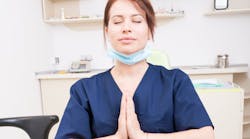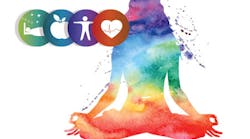The power of alignment: Yoga therapy for dental hygienists
Working in dentistry can be challenging—physically, mentally, and emotionally. One report shows that 91% of dental hygienists are experiencing or have experienced work-related pain during their careers, and another study shows that one in three dental hygienists show signs of burnout.1-3 I’d like to discuss yoga therapy as an option to support the well-being of hygienists.
Yoga is viewed in many ways, depending on knowledge and experience. For some people, it’s simply stretching. For others, it’s a fitness class with cardio and weights. For some, it’s deeply restorative and therapeutic.
At its core, yoga means to yoke or union; to come together. However, there are many different styles of yoga, and not every style suits everyone’s goals and needs. Yoga therapy specifically tailors yoga practices to address individual health issues and goals.
Contrary to popular belief, yoga isn’t just fancy poses. It’s a comprehensive practice that includes postures/poses, breathing practices, and meditation, and it focuses on developing deeper self-awareness. Yoga has been studied for years, and research about its benefits is expanding.
Some forms of yoga have been shown to improve chronic and acute pain, aid injury recovery, and improve posture.4-7 Yoga can also be a complementary therapy for stress, anxiety, depression, and mood disorders, and supporting relaxation, greater well-being, self-confidence, and improved interpersonal relationships.8-11
I’ll review how yoga, in its therapeutic form, can help dental hygienists find greater alignment for body, mind, and energy.Physical alignment: Posture and ergonomics
Due to the high number of dental hygienists who experience work-related pain, new tools and resources are essential. Hygienists spend much of their day sitting, leaning, twisting, reaching, and rounding to work effectively inside patients' mouths. As a result, neck, lower back, hips, upper back/shoulders, and hands/wrists are common areas of pain and injury.¹
While improving chairside ergonomics is crucial, it’s equally important for hygienists to engage in practices that support their posture and physical well-being. Yoga has been shown to reduce tension from tight, overworked muscles, improve circulation, build strength, and rebalance the body from prolonged sitting.4-6
Developing a consistent yoga therapy practice could help dental hygienists reduce the risk of injury and pain while improving posture and alignment. I recommend classes that focus on therapeutics, alignment, and restoration; classes that are slow and intentional allow practitioners to focus on their body and movements without risking injury.
Yoga can also be used to help with specific areas of the body. For example, if a hygienist has hand and wrist pain, they can focus on yoga stretches and strengthening practices for those areas, such as wrist rolls and prayer hands to stretch the palm of the hand.⁷
Yoga can also be implemented chairside throughout the workday. Stretches such as cat/cow, chest openers, lateral bends, forward folds, and gentle twists can be practiced during the morning huddle, in between patients, or at the end of the day to maintain health and reduce recovery time after work. These foundational postures help keep the spine and back healthy but stretches that focus on the whole body or specific areas of the body that need attention can also be included.
Mental alignment: Managing stress and mindset
One study shows that one in eight hygienists feel emotionally exhausted from work. Factors contributing to this stress include musculoskeletal pain, work/life balance, long working hours, lack of support, difficult patients, doubts about capabilities, and lack of management support.¹²
Yoga can help with stress too. It’s been shown to reduce stress and support a healthier functioning nervous system.¹³ One study found that symptoms associated with stress, anxiety, and depression were significantly reduced after 12 yoga sessions.⁸ Yogic breathing practices, or pranayama, help reduce stress and negative emotions while improving cognitive performance.⁹ Incorporating yoga, breathing practices, and meditation into regular routines can improve sleep, reduce stress, and enhance overall cognitive function.¹⁰
Since breath has a direct connection to the nervous system, hygienists can use breathing practices throughout the workday. One can take long, slow breaths, focusing especially on long exhalations, during stressful moments. This activates the parasympathetic nervous system, resulting in a feeling of calm in the moment.
Practices such as box breathing, which involves creating an even count for each part of the breath (inhale, retention, exhalation, and suspension), can be implemented during stressful times, difficult patient interactions, or between appointments. By implementing breath work, mindfulness, and yoga stretches into the daily routine at work, we reduce stress throughout the day and accumulation of stress at the end of the day.
Energetic alignment: Preventing burnout
The World Health Organization (WHO) defines burnout as a syndrome that results from chronic workplace stress that has not been effectively managed. It’s characterized by exhaustion, negative feelings toward one’s job, and decreased work effectiveness.¹⁴ Dentistry comes with its fair share of accumulated stress—physical, mental, and emotional—including carrying the weight of patient care, prioritizing the needs of patients, and toxic work environments.
Yoga, breath work, and meditation have all been shown to help with stress and burnout. Therefore, practitioners can use yoga as a whole, or parts of the practice to build resilience, combat fatigue, and prevent burnout.⁹
One practice that is incredibly supportive for stress and burnout is Yoga nidra. Yoga nidra, commonly known as “yogic sleep,” is a form of meditation (requiring no movement) that systematically relaxes the body and mind, promoting deep relaxation and restoration. This practice has been studied and shown to help with stress, sleep, and overall well-being.15-17 Yoga nidra is great to do before bed or as a break during the workday.
Clinicians can also practice mindfulness and meditation at work to increase present-moment awareness, calm, and focus to improve stress resilience over time. Practices such as body scans and progressive muscle relaxation are easy options. A body scan means taking a few moments to slow down and bring awareness to different parts of the body. Progressive muscle relaxation is similar but focuses on relaxing each part during the scan.
Yoga therapy offers dental hygienists a holistic approach to achieving physical, mental, and energetic alignment, helping them manage pain, reduce stress, and prevent burnout. By incorporating yoga into their daily routines at work and home, dental hygienists can enhance their well-being and thrive in their profession.
Editor's note: This article appeared in the Aug/Sept 2024 print edition of RDH magazine. Dental hygienists in North America are eligible for a complimentary print subscription. Sign up here.
References
1. Saccucci M, Zumbo G, Mercuri P, et al. Musculoskeletal disorders related to dental hygienist profession. Int J Dent Hyg. 2022;20(3):571-579. doi:10.1111/idh.12596
2. Ćwirzeń W, Wagner L. Evaluating the dental hygienists' exposure to the risk of musculoskeletal disorders. Eur J Dent. 2023;17(3):629-635. doi:10.1055/s-0042-1750772
3. Bercasio LV, Rowe DJ, Yansane AI. Factors associated with burnout among dental hygienists in California. J Dent Hyg. 2020;94(6):40-48.
4. Koneru S, Tanikonda R. Role of yoga and physical activity in work-related musculoskeletal disorders among dentists. J Int Soc Prev Community Dent. 2015;5(3):199-204. doi:10.4103/2231-0762.159957
5. Schmid AA, Fruhauf CA, Sharp JL, Van Puymbroeck M, Bair MJ, Portz JD. Yoga for people with chronic pain in a community-based setting: a feasibility and pilot RCT. J Evid Based Integr Med. 2019;24:2515690X19863763. doi:10.1177/2515690X19863763
6. Sharma, Sachi; Rawat, Vikas. Effect of Yogic practices on body posture and its correlation with physical and mental health in adolescents. Indian J Med Specialities. 2023;14(4):216-224. doi:10.4103/injms.injms_56_23
7. Krishnamurthy MN. Yoga as part of sports medicine and rehabilitation. Int J Yoga. 2023;16(2):61-63. doi:10.4103/ijoy.ijoy_212_23
8. Shohani M, Badfar G, Nasirkandy MP, et al. The effect of yoga on stress, anxiety, and depression in women. Int J Prev Med. 2018;9(2):21. doi:10.4103/ijpvm.IJPVM_242_16
9. Woodyard C. Exploring the therapeutic effects of yoga and its ability to increase quality of life. Int J Yoga. 2011;4(2):49-54. doi:10.4103/0973-6131.85485
10. Tavoian D, Craighead DH. Deep breathing exercise at work: Potential applications and impact. Front Physiol. 2023;14(1):1040091. doi:10.3389/fphys.2023.1040091
11. Ma X, Yue ZQ, Gong ZQ, et al. The effect of diaphragmatic breathing on attention, negative affect and stress in healthy adults. Front Psychol. 2017;8(6):874. doi:10.3389/fpsyg.2017.00874
12. Gorter RC. Work stress and burnout among dental hygienists. Int J Dent Hyg. 2005;3(2):88-92. doi:10.1111/j.1601-5037.2005.00130.x
13. Khajuria A, Kumar A, Joshi D, Kumaran SS. Reducing stress with yoga: a systematic review based on multimodal biosignals. Int J Yoga. 2023;16(3):156-170. doi:10.4103/ijoy.ijoy_218_23
14. World Health Organization. Burn-out an “occupational phenomenon”: International classification of diseases. World Health Organization. May 28, 2019. https://www.who.int/news/item/28-05-2019-burn-out-an-occupational-phenomenon-international-classification-of-diseases
15. Jhinkwan A, Sharma N, Suryawanshi K. Effect of yoga nidra in alleviating burnout among school teachers: A randomized controlled trial. Int J Yogic, Human Movement Sports Sci. 2024;9(1):399-402. doi:10.22271/yogic.2024.v9.i1f.1585
16. Sharpe E, Butler MP, Clark-Stone J, et al. A closer look at yoga nidra-early randomized sleep lab investigations. J Psychosom Res. 2023;166:111169. doi:10.1016/j.jpsychores.2023.111169
17. Ferguson K. The effects of a yoga nidra practice on mental health clinicians’ perceived stress. Semantic Scholar. 2016. Accessed June 11, 2024. https://www.semanticscholar.org/paper/The-effects-of-a-yoga-nidra-practice-on-mental-Ferguson/5a126e0b5ca296bc7407561b97a07c5b6319b1fd
About the Author

Caitlin Parsons, RDH, C-IAYT, CEAS
Caitlin Parsons, RDH, C-IAYT, CEAS, is a practicing dental hygienist, yoga therapist, ergonomics expert, and the founder of The Aligned Hygienist. She is a writer, public speaker, consultant, podcast host, and content creator. Caitlin specializes in ergonomics, yoga therapy, pain prevention, stress management, and burnout for dental professionals, teams, and organizations. Contact her at [email protected].


